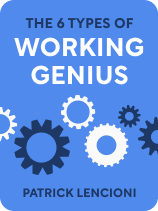

This article is an excerpt from the Shortform book guide to "The 6 Types of Working Genius" by Patrick Lencioni. Shortform has the world's best summaries and analyses of books you should be reading.
Like this article? Sign up for a free trial here.
What is the competency mapping process? How should you organize your team by their skills and abilities?
Employees need job titles and descriptions so they know where they fit in with the company. Competency mapping ensures that everything is running smoothly by matching specific skills with certain roles.
Below we’ll discuss how the competency mapping process works, as described in The 6 Types of Working Genius by Patrick Lencioni.
Mapping Genius
Lencioni encourages mapping your team members’ intelligence types out through a competency mapping process. This allows you to evaluate your team’s current skillset and where improvements and/or additions are advisable.
To do this, Lencioni suggests listing each intelligence type in the order it appears in the phases of work: Perceiving Opportunity, Innovating Solutions, Vetting Ideas, Mobilizing People, Supporting, and Seeing Things Through. Alongside each, place a field with two columns. In the left-hand column, put the team members who excel in that intelligence; on the right, list those who struggle with it.
Lencioni doesn’t map team members’ intelligences here. Instead, Lencioni emphasizes that you should use the map primarily to visualize major strengths and weaknesses.
Making the Most of Maps
Lencioni asserts that using his team map is one of the most potent possible tools to engage employees with his intelligence model. As a result, it is a vital vehicle for enabling mutual understanding. Team mapping in itself is a popular implement for managers seeking to better understand their people. Forms of assessments and resulting maps are quite diverse in approach, topic, and complexity, and often entail financial investment to perform. Here are some best practices in administering them:
- Research beforehand to discover your options and find the right fit.
- Inform employees beforehand for suggestions and to allay any concerns they may have about taking the evaluation.
- Whenever possible, make participation voluntary.
- Let the team know how and when the results will be delivered.
- Make sure to allow yourself ample time to digest the results and apply them to tangible management strategies.
- Engage each team member on their own concerning the results, optimally providing the most non-threatening environment possible.
Harvesting the Map’s Information
Lencioni insists that the benefits of mapping go well beyond knowing who’s who. You can visually conceptualize where your organization is adequately staffed—in other words, how deep is your proverbial bench? In studying the map, you can then ask key questions:
- Is anyone over-extended because they’re the only one on your team possessing one of the intelligences?
- Likewise, is anyone burning out because their competencies too often have to compensate for deficits of intelligence?
- Who might be “under-utilized” because their true skill set remains unacknowledged? And how can this add balance and bandwidth to the team?
Takeaways from these and similar questions can inform big choices or, at least, important follow-up questions:
- Can you fill gaps solely by moving around existing personnel?
- Can you transfer/borrow people from other departments or teams?
- Is hiring an option? If so, for which intelligences and competencies?
| To Hire or Not to Hire Lencioni makes clear that identifying intelligence types can lead to opportunities for reorganization and hiring of employees, both of which have intrinsic benefits. Nonetheless, some of the most significant benefits of reorganization over hiring pertain to cost. For instance, it can frequently take between eight to ten weeks just to hire a new employee, forcing the manager to seriously consider the urgency of the work they’re hiring for. Leaders must weigh the investment involved in advertising, screening, interviewing, and potentially relocating possible candidates. And many of the other costs of hiring are not so obvious, including the resources you must divert—particularly the time of some of your most productive employees—to onboard new people. |

———End of Preview———
Like what you just read? Read the rest of the world's best book summary and analysis of Patrick Lencioni's "The 6 Types of Working Genius" at Shortform.
Here's what you'll find in our full The 6 Types of Working Genius summary:
- The six types of working intelligence that successful teams need
- How to identify which traits your team members have
- How to apply the six types of genius to bolster workflow and well-being






